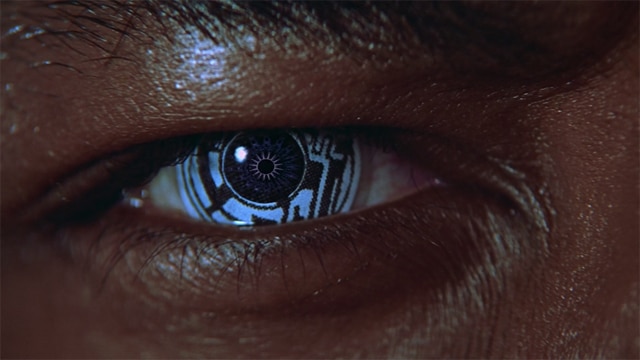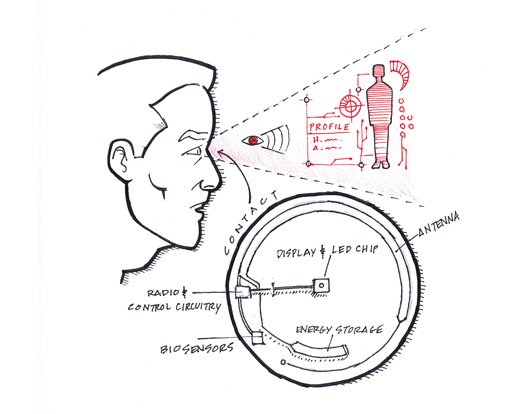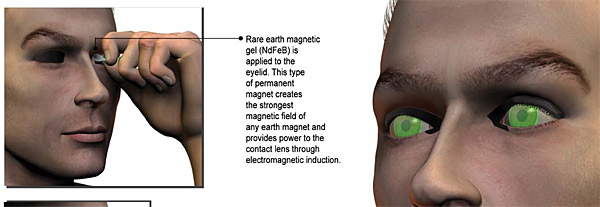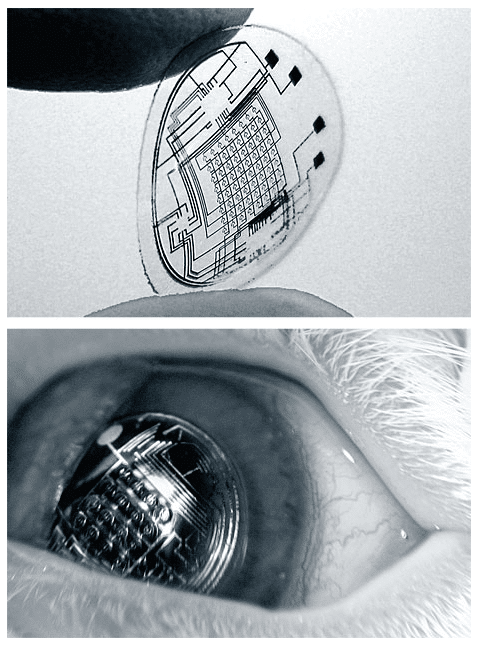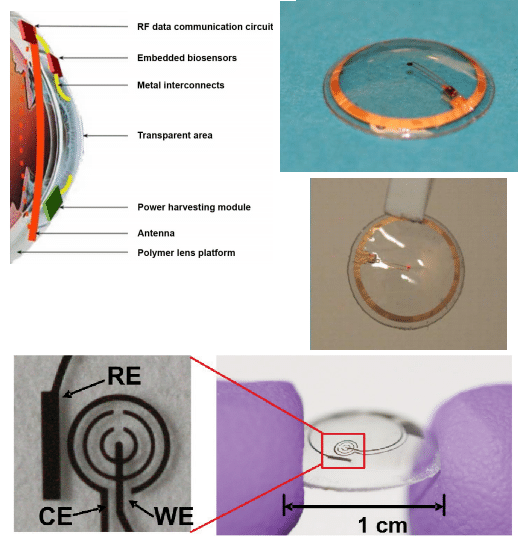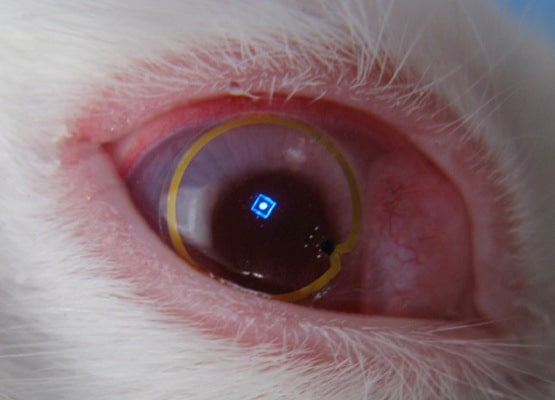
Can you imagine contact lenses that give you a see-through display that connects via Bluetooth into your iPhone? Maybe something that allows you to get news stories as they pop up, see email notifications in your vision, or perhaps maybe even something actually useful? The people at the University of Washington have developed a test case of this exact scenario — albeit in the eye of a rabbit. But if Bugs Bunny can see like the Terminator, with images and text, then where’s the limit? I submit it’s the SKY!
From the University of Washington’s press release, cross-posted from the Journal of Micromechanics and Microengineering:
We present the design, construction and in vivo rabbit testing of a wirelessly powered contact lens display. The display consists of an antenna, a 500 × 500 µm2 silicon power harvesting and radio integrated circuit, metal interconnects, insulation layers and a 750 × 750 µm2 transparent sapphire chip containing a custom-designed micro-light emitting diode with peak emission at 475 nm, all integrated onto a contact lens. The display can be powered wirelessly from ~1 m in free space and ~2 cm in vivo on a rabbit. The display was tested on live, anesthetized rabbits with no observed adverse effect. In order to extend display capabilities, design and fabrication of micro-Fresnel lenses on a contact lens are presented to move toward a multipixel display that can be worn in the form of a contact lens. Contact lenses with integrated micro-Fresnel lenses were also tested on live rabbits and showed no adverse effect.
Let’s hit some key points here:
- Part of the purpose of this most recent test was to test the safety of this device on a live subject.
- Scientists tested a real, live, working video contact lens display on a real, live, BREATHING AND POOPING RABBIT (that’s what in vivo means, basically not diced up into dead tissue)
- The device had wireless power, and everything needed is integrated into the tiny contact lens
- No bad effects were observed on the rabbit, which was anesthetized
- The contact lens had one pixel, but the next phase is a micro-Fresnel multi-pixel display lens, which were also tested on the bunnies, with no apparent bad effects.
This is, by all accounts, AMAZING! Can you imagine the implications of having a see-through display in your vision?! From my lighting designer mind, I see things like photometric data or spectrophotometric data just updating as you look at something? I hate to be the one to state this, but you KNOW the Defense Department is going to get their hands on this if they haven’t already — and we’ll see the next round of soldiers equipped with instant range finding and targeting displays right there in their vision as if it was nothing at all. Seal Team 6, for example, was rumored to be wearing night vision contact lenses on the raid in Abbottabad, Pakistan on Osama Bin Laden. A rumor of course, but is it really that inconceivable that something along those lines is possible? I think not!
We’re still quite a bit away from the kinds of retina display technology we see in the movies — for example, in Mission Impossible 4 when Josh Holloway was in the train station looking at people’s faces as they passed by — but that technology is definitely going to be hitting our wallets in the next decade. Call it intuition, call it a gut feeling, I don’t know. But the interface is already there, Edward Snowden has made us very aware of that — and if it’s not already there by now, I have to believe that it isn’t way too far behind development.
We already have license plate scanning cameras that police drive around with as they do their patrols. We have data systems that can mine faces and scan instantly as people pass by the sensors. What’s to say that soon we can’t have a device you go purchase at the local high end electronics retailer that allows you to shop for something anywhere, and while you’re looking at things in the store, you’re getting a display of the current price on Amazon versus what you’re seeing at Target? Amazing thought, huh!
From an excellent article written in the IEEE Spectrum back in 2009, when the thought of monitoring someone’s blood glucose was an excellent reason for developing a technology like the one being tested today:
These lenses don’t need to be very complex to be useful. Even a lens with a single pixel could aid people with impaired hearing or be incorporated as an indicator into computer games. With more colors and resolution, the repertoire could be expanded to include displaying text, translating speech into captions in real time, or offering visual cues from a navigation system. With basic image processing and Internet access, a contact-lens display could unlock whole new worlds of visual information, unfettered by the constraints of a physical display.
Besides visual enhancement, noninvasive monitoring of the wearer’s biomarkers and health indicators could be a huge future market. We’ve built several simple sensors that can detect the concentration of a molecule, such as glucose. Sensors built onto lenses would let diabetic wearers keep tabs on blood-sugar levels without needing to prick a finger. The glucose detectors we’re evaluating now are a mere glimmer of what will be possible in the next 5 to 10 years. Contact lenses are worn daily by more than a hundred million people, and they are one of the only disposable, mass-market products that remain in contact, through fluids, with the interior of the body for an extended period of time. When you get a blood test, your doctor is probably measuring many of the same biomarkers that are found in the live cells on the surface of your eye–and in concentrations that correlate closely with the levels in your bloodstream. An appropriately configured contact lens could monitor cholesterol, sodium, and potassium levels, to name a few potential targets. Coupled with a wireless data transmitter, the lens could relay information to medics or nurses instantly, without needles or laboratory chemistry, and with a much lower chance of mix-ups.
Three fundamental challenges stand in the way of building a multipurpose contact lens. First, the processes for making many of the lens’s parts and subsystems are incompatible with one another and with the fragile polymer of the lens. To get around this problem, my colleagues and I make all our devices from scratch. To fabricate the components for silicon circuits and LEDs, we use high temperatures and corrosive chemicals, which means we can’t manufacture them directly onto a lens. That leads to the second challenge, which is that all the key components of the lens need to be miniaturized and integrated onto about 1.5 square centimeters of a flexible, transparent polymer. We haven’t fully solved that problem yet, but we have so far developed our own specialized assembly process, which enables us to integrate several different kinds of components onto a lens. Last but not least, the whole contraption needs to be completely safe for the eye. Take an LED, for example. Most red LEDs are made of aluminum gallium arsenide, which is toxic. So before an LED can go into the eye, it must be enveloped in a biocompatible substance.
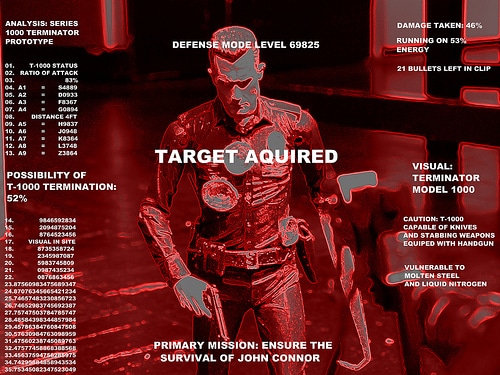 More from the press release at the University of Washington:
More from the press release at the University of Washington:
At the moment, the contact lens device contains only a single pixel of information, but the researchers say it is a proof of the concept that the device could be worn by a person. Eventually it could display short emails and other messages directly before a wearers eyes.
“This is the first time we have been able to wirelessly power and control the display in a live eye,” said Babak Parviz, an author and UW associate professor of electrical engineering. Among his coauthors are Brian Otis, associate professor of electrical engineering, and Andrew Lingley, a graduate student.
“Looking through a completed lens, you would see what the display is generating superimposed on the world outside,” Parviz explained during a 2008 interview.
The researchers findings were published Nov. 22 in the Journal of Micromechanics and Microengineering.
Perhaps the best-known science fiction character to use such a display is the Terminator, and for almost seven years Parviz and others have worked on trying to make the display a reality.
Building the lenses required researchers to make circuits from metal only a few nanometers thick, about one-thousandth of a human hair. They built light-emitting diodes (LED) one-third of a millimeter in diameter. And to help focus the images, the researchers made arrays of tiny lenses that were put into the contacts.
The contact lens has an antenna to take power from an external source, as well as an integrated circuit to store this energy and transfer it to a transparent sapphire chip containing a single blue LED.
Otis called this successful wireless transmission to a lens “an extremely exciting project … that presents huge opportunities for health-care platforms.” The team is working on a way to monitor a diabetic patients glucose level using lenses.
Check this out, it’s three minutes worth of awesomesauce — some of this project from back in 2011:
GAH! What an awesome project!

